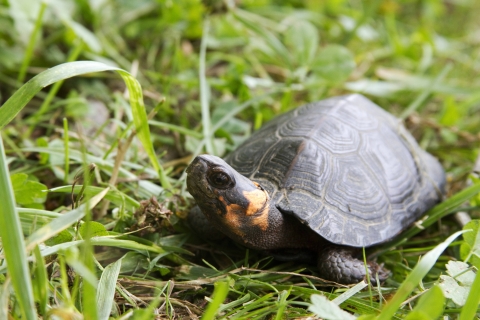One of the smallest turtles in the world makes its home here in the eastern U.S. No bigger than 4.5 inches long, the federally protected bog turtle (Clemmys muhlenbergii) is still struggling 24 years after receiving protection as threatened under the Endangered Species Act. Not because it's small — because of a combination of loss of habitat and illegal turtle trafficking.
“They’re the smallest, and arguably the cutest, turtle in the U.S.,” said Lori Erb, conservation specialist for the Mid-Atlantic Center for Herpetology and Conservation. “And they’re so good at hiding that someone could have bog turtles in a wetland on their property and never know it.”
Their size along with the orange or yellow patch on their heads makes them easy to distinguish. Bog turtles have a southern population from Virginia to Georgia and the northern population runs from New York and Massachusetts down to Maryland.
The bog turtle’s northern range overlaps with much of the area known as the Highlands Region, a span of 3.4 million acres of Appalachian hills, ridges and valleys in Connecticut, New York, New Jersey and Pennsylvania, which is the focus of the U.S. Fish and Wildlife Service’s Highlands Conservation Act grant program.
The Highlands Conservation Act was enacted by Congress in 2004 to provide funding for land conservation projects in the Highlands Region that conserve wildlife, protect drinking water, save forests and agricultural lands, and create recreational opportunities for the public. State agencies, private landowners, and nonprofit land trusts work side by side with the Service to create proposals for HCA land acquisition grants.
“The HCA is helping preserve acres of land that the bog turtle needs to survive,” said Colleen Sculley, Assistant Regional Director for the Service’s Wildlife and Sport Fish Restoration Program. “Preserving these key natural areas in the Highlands Region not only protects important habitat for threatened and endangered wildlife but also provides other benefits, like protecting drinking water supplies and providing access to nature for millions of people.”
The bog turtle thrives in emergent marsh and open-canopy wetlands, which in the past was often filled in to make room for development. Even if habitat is not directly destroyed, alterations to the hydrology of the landscape can cause changes to the vegetation in nearby bog turtle habitats. “Next to development, the top threat to the bog turtle is the succession of open canopy, wet meadow and fen habitat to forest, making habitat management a key tool to the recovery of this species,” said Erb.
So far, the HCA has helped preserve over 12,800 acres. One result has been enhancing landscape connectivity by joining conservation areas that were previously disconnected. According to Jesse Jaycox, a Wildlife Biologist for New York Office of Parks, Recreation and Historic Preservation, the permanent protection of suitable nesting habitat and traveling corridors is vital to helping connect different areas of the bog turtle habitat. “Land conservation in the area helps protect water quality and preserve potential habitat for wildlife. These sites can be used for reintroduction of bog turtles” said Jaycox.
Noelle Rayman-Metcalf, biologist with the Service’s New York Field Office adds that “reintroduction of bog turtles to certain areas may be a possibility in the future and knowing that areas of suitable habitat are already protected, if there is a need to do reintroductions, is extremely helpful.”
By acquiring new habitat and linking conservation areas together, the Highlands Conservation Act program is expanding horizons for this rare turtle species.





